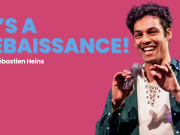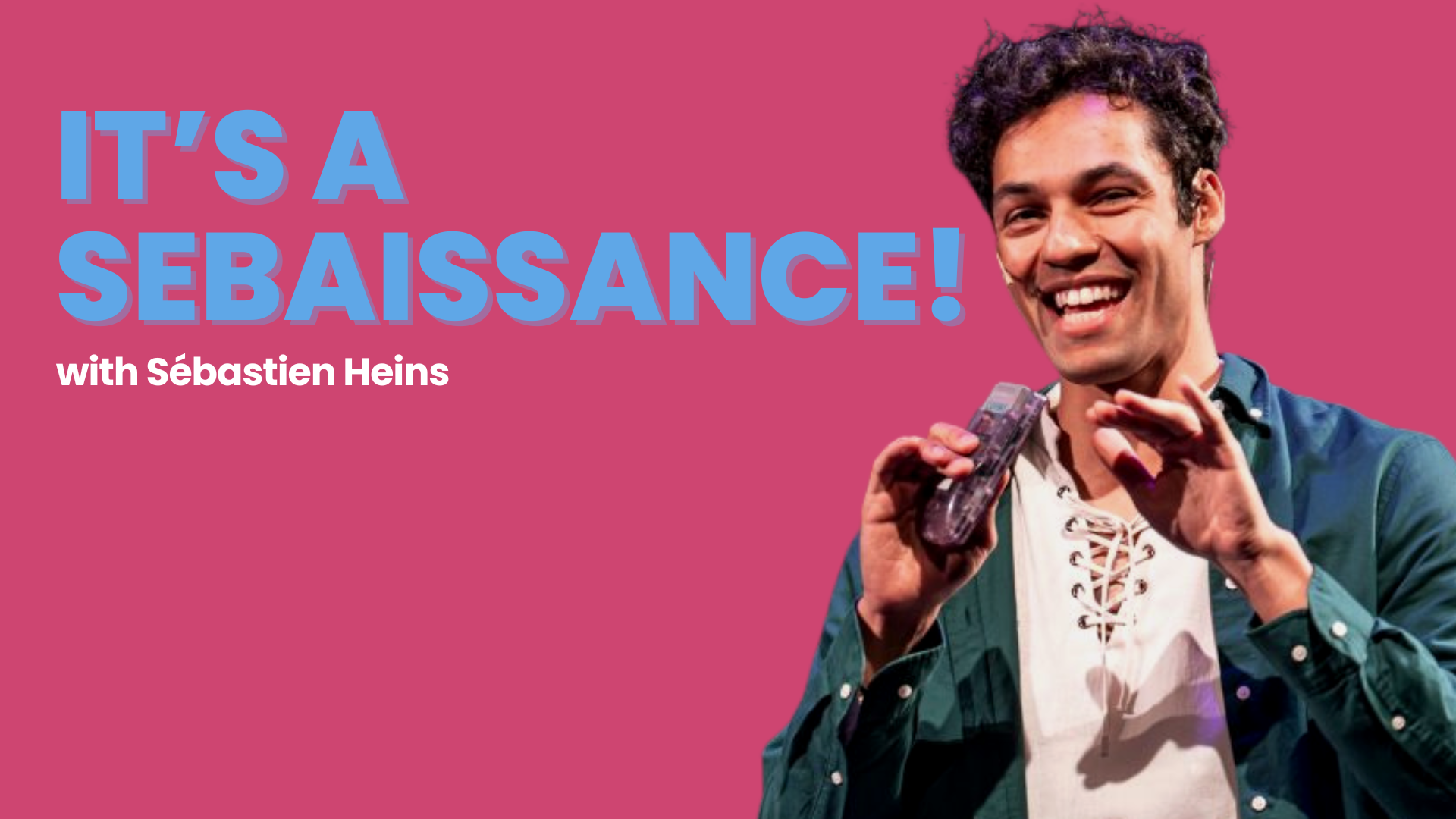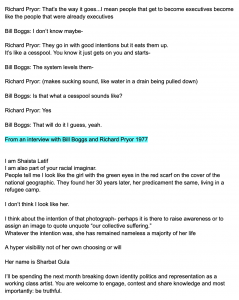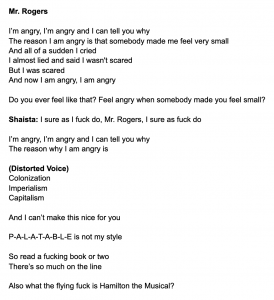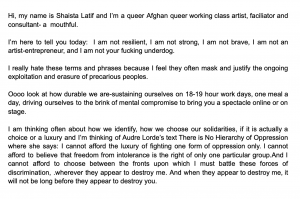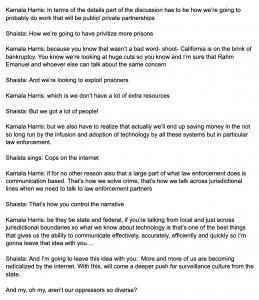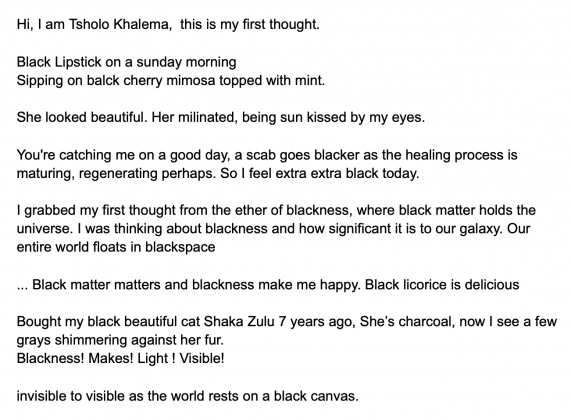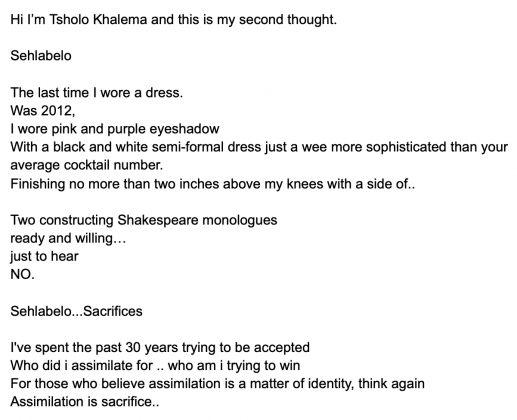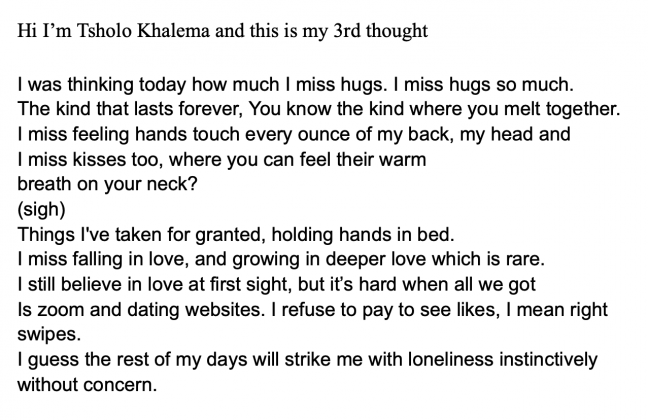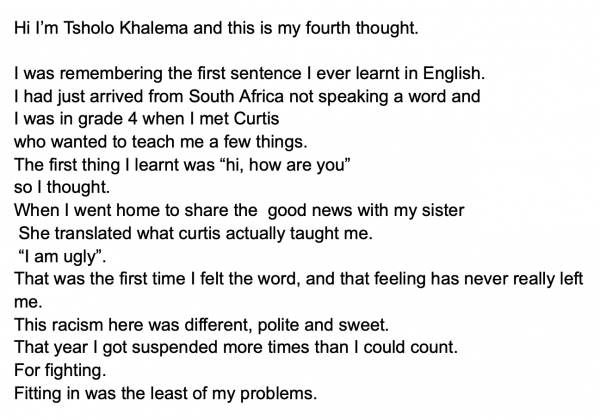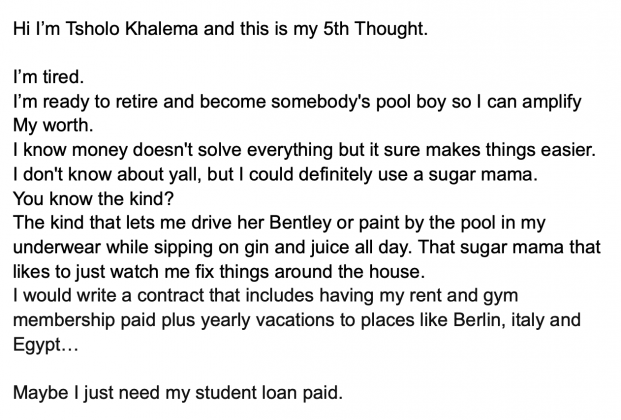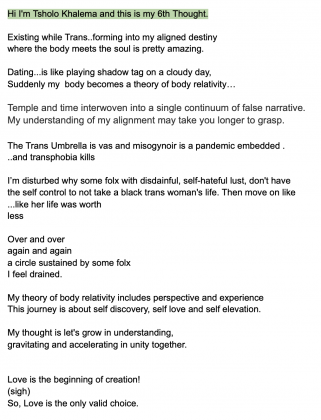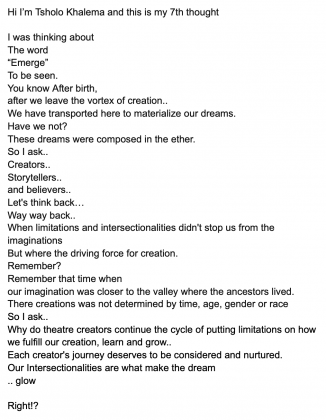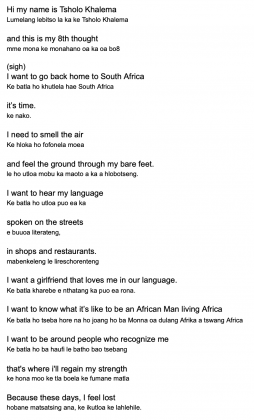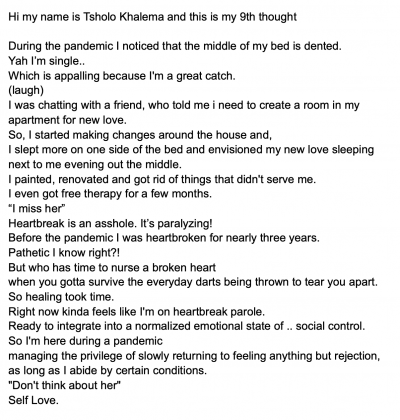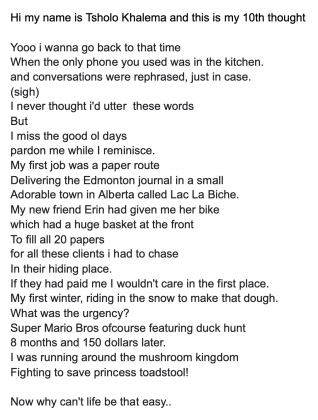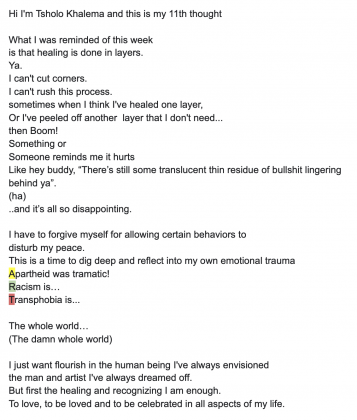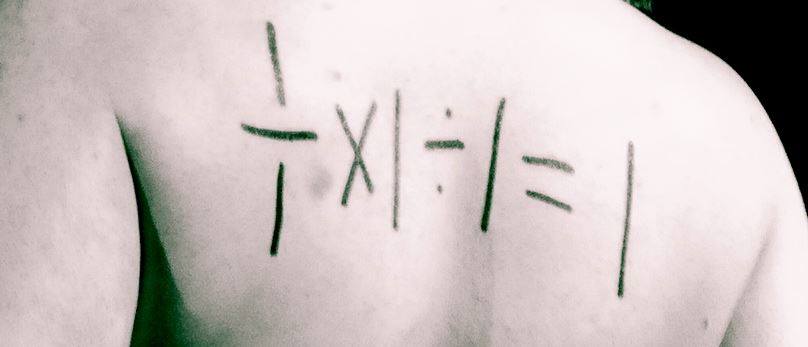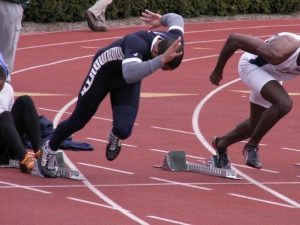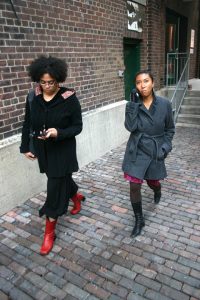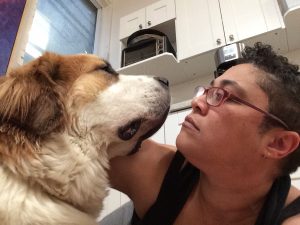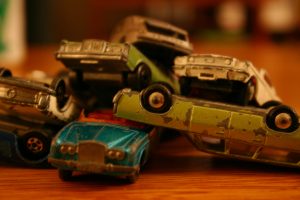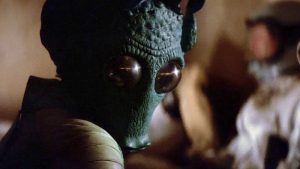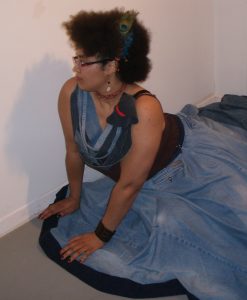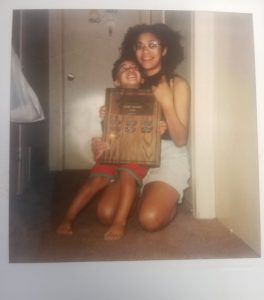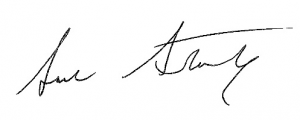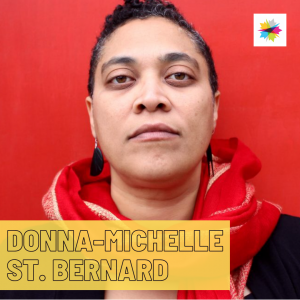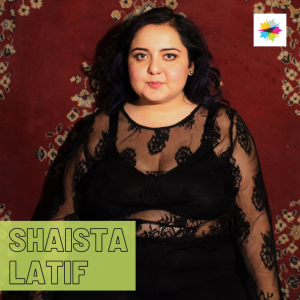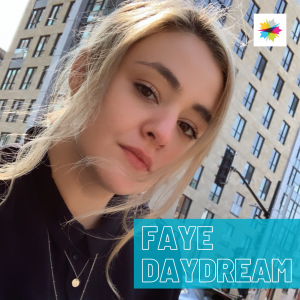Thought Residencies: Code Has To Be About Love | Dr Pratim Sengupta
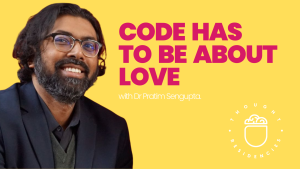 Marcel Stewart is joined by Dr. Pratim Sengupta to discuss thinking with our bodies, Mind Matter and Media Lab, pushing back against symbolic violence, dignity bombs, human beings as pain catastrophizers, technocentricsm, moving through the world with love, the Festival of Live Digital Art and MORE!
Marcel Stewart is joined by Dr. Pratim Sengupta to discuss thinking with our bodies, Mind Matter and Media Lab, pushing back against symbolic violence, dignity bombs, human beings as pain catastrophizers, technocentricsm, moving through the world with love, the Festival of Live Digital Art and MORE!
*there is slight background noise throughout by way of microphone feedback and an infant doing what infants do.
**Adrienne Wong and Xianzhi Jason Li facilitated the workshop ‘Artificial Intelligence in Live Performance’ that Dr. Sengupta references.
Marcel Stewart
Coming up a conversation with Dr. Pratim Sengupta. We talk about moving through the world with love, techno centrism, pushing back against symbolic violence, thinking with our bodies, and the Festival of Live Digital Art. Next.
So, just to start us off, I’d love to give you a moment to introduce yourself and just take as much time as you need to let us know you are.
Pratim Sengupta
Okay, I’m Pratim Sengupta. And I’m a professor at the University of Calgary. I live really between a few disciplines. But the two I most centrally live between are education and computer science, and my specific field is called Learning Sciences. And what I do for research is I design and build technologies that are heavily computational. So the programming languages or computer models or games, that was work I did a while back, but you know, in the now. And that allow us to explore complex phenomena. So flocking of birds, or traffic jams, or forest fires, or urban transportation systems, or racial segregation. And mathematically, they live in a certain kind of frame. And that’s how I sort of I got started. And then the work became more about the people who were being represented in the models, but also people who are interacting with the models. And then I slowly over time realized that the stories with the peoples, the heart is with the peoples. And so that’s sort of where I’m at research wise, the work has taken on a heavily decolonial bent, and anti racist bent through different collaborations. And where I connected with art was, while doing this work of building computer models and programming languages, I started collaborating with artists and building different kinds of systems. Like, for example, what would it mean for artists to be able to cite each other in their creations. And so we did in back in 2012, we did an installation at the MoMA in New York City where we built this crowd sourced network visualization software that allowed artists to input their work, descriptions of their work, tag other artists, that they’re influenced by, tag other artists they want to influence. And so you could see like the world of artists’ social practice, lighting up with different ideas, people and how they’re connected to one another, or connections that they foresee that are not, might not be realized yet. And then since I moved to Canada, I started doing, designing sort of these, what we call now public computing. So taking computer programming languages, and particular models in designing those languages that were originally created by computer scientists, we just take it in public spaces, and completely make it open. Like here is the original code, here is the tech, here is–and what we learned through research is that art is not just about putting an object idly in front of human beings, it’s actually about the relationship and fostering and supporting the relationship between people and these objects, people and technologies, people and new languages. And so that sort of where, sort of, you know, this design of technologies became sort of artistic work, as well as research for me, and then slowly, research became art for me. So we took the flocking algorithm and just allows us to simulate how flocks of birds come together without necessarily there being a leader bird, always, to just three simple rules like cohesion, alignment and separation. If you have a system of 100 birds, and each of the birds you’re trying to align with the closest bird, separate just enough, and then go here, move with a group, then we are going to see the formation of flocks. And then we took that algorithm. And then we modeled flocking of Maple Leafs on Canada Day 2018, at Canada’s National Music Center, and 14,000 people showed up. Many of them used, really interacted with the simulation, but the interactions, where what we did was we allowed people to take a microphone and say anything they wanted, and we took that vocal frequency. And we, we made the flocking algorithm tune with the frequency so that the frequencies were processed and numbers were generated. And those numbers became part of the flocking algorithm. And then we saw the most amazing thing. You know, almost, well, some people did sing, ‘oh Canada’, but mostly people were singing so many other songs all the way from ‘Jingle Bells’ to Islamic chants, to Hindu prayers, to songs in Polish. And near the end of the day, you know, like this elderly person who keeps coming back throughout the day, and slowly walks up to the mic and slowly keeps walking back. And at the end of the day, we’re just about to take things apart. She walks out, and tells me that she wants to sing a song in Polish. And if we still had time, and she said, “It’s a special song, I used to sing it, but 50 years back growing up in the hills in Poland, where my job was to as a little girl was to herd a flock of sheep. And this was the song that they responded to.” And she sang that song in Polish. And she said that I’m going to herd all the birds, all the leaves at the end of the day. So that, you know, and that experience was a profound shift in my life. Right. And there’s this idea called heterotopia, which Michel Foucault talks about, it’s, you know, it’s, these are, these are the brothels in our city, these are the spaces that we tend to overlook, but they exist. And they’re the kings in our, the kings in our heavily normal space. You know, the, the ghettoization of our cities, the nooks and crannies that we know exist there. So they’re actually some of the liveliest spaces in our society where life exists, beyond the bureaucracy, beyond the laws, beyond the coloniality of our everyday existence, right. And I felt like that day, you know, the national anthem ceased to exist. In that space, it wasn’t–And like a switch was flipped in my head that I didn’t go in to decolonize. But the people did. Right, and so it wasn’t about the technology, it was about the people. And yet, there was something about the flocking, there was something about being able to engage with that flow on screen in a way that they could see a part of themselves. Right. So it’s part code part human. But it’s not just–and, this is, I’m still grappling with it. And these are people now in CTR, the Canadian Theatre Review that’s coming out on this. It’s actually being edited by wonderful FOLDA colleagues and academics. Right. And that power kind of things began.
Marcel Stewart
Yeah, that’s amazing. The synergies in that way, right. Yeah. Okay. You like Thank you. I have many questions already about public computing. I’d love you to speak about flocking, I’d love you to speak about. I’d love to go back to it. But I’m curious like today. What is the day? It’s Wednesday, the 18th of October, like what are you thinking about today? Like what’s on your mind? What has been on your mind? What’s taking up your brain space today?
Pratim Sengupta
So right before coming to do this talk, I was doing another interview with colleagues of mine from different departments and disciplines and universities. And we are coming together and beginning this project on reimagining active mobilities, like cycling, walking wheelchair users, in urban spaces through centering marginal experiences of people of color, who don’t even get counted by the city as users of active mobility, you know, in some spaces. And newcomer youth, especially if they’re of color, and they appear Muslim, they are, you know, harassed on public transit. They’re harassed on these in these active mobility spaces. Right. So what does it mean to actually reimagine what environmental science can do, what public health can do, what sociology can do, and what public education can do? If we center the perspectives of these youth in these spaces? And so that’s sort of what I was thinking. Right before and then in the transition period, I was thinking about the experience that stuck with me the most from FOLDA, right. Which is what brings me here. I had a beautiful title, Thinker in Residence, without the peeing in public part. Should sit like this and pee while I’m sitting.
Marcel Stewart
That’s good. That’s good.
Pratim Sengupta
Oh, no, I have a feeling, you know, I would have just started a trend and others would have joined.
Marcel Stewart
Listen, when you gotta go.
Pratim Sengupta
Right. As a cyclist, I often have to do that.
Marcel Stewart
As a parent of a toddler, we have to do that. Sometimes you got to pull over on the side of the road.
Pratim Sengupta
And your child was born during FOLDA, if I remember correctly, right?
Marcel Stewart
Yes. My second born, Correct. Yes. .
Pratim Sengupta
I remember that. I was looking forward to meeting you. And then I was told that oops, he’s a parent. Is another parent.
Marcel Stewart
Nature said “Not today. Not 2023 FOLDA”. Yeah, we’ll come back next year.
Pratim Sengupta
But from FOLDA, what stayed with me the most was–and this is what I was thinking of–Was the ‘Exploring Physical Sound from a Deaf Perspective.’ That workshop. And yeah, she’s Chisato Minamimura I think. And, you know, my best friend is a very physical actor. And he’s sort of this unique nook in the world is he does this one person performances where he plays multiple characters, you write sort of a journalistic theater. Dan Hall, that’s his name. And we kind of grew up together as adults and human beings and person I know the longest in my life and have had, like a really really powerful relationship with him. We know each other for almost a quarter century now. And we’ve been very, very close buddies. And it’s one reason it resonated with me is because of the physicality through which I learned to think as I saw Dan become an actor. Like he taught me that we think with our bodies, and the mind is also a part of our body. And we can become someone else. Never really fully but we can learn how important it is to recognize the agency our flesh and bones have and muscles have in making us feel for others and be with others. Right, and not like completely centralizing everything here, which anyway is a myth. Right? There is this blood circulation that’s happening from all over my body. I’m reacting to society. I’m reading air and there microorganisms that are empowering me and also tickling me all over and that you know, like this is–and we ignore all of that and we say that, “No, there is a mind.” And we will adjust. And in that workshop Chisato, I think almost pinpointed what this was all about. Digital art, live digital art, was all about, it’s about our souls. And it’s, it’s about how we recognize and acknowledge that we are part of a flow with others. And it’s not just the technique. In fact, it’s not at all the technique, right? We can communicate with touch. We can communicate without touch. We can communicate, through stillness. We can communicate through so many different ways. But sometimes in that workshop, some of those communications became feelings that were shared. And feelings that someone else’s feelings became mine. I embodied them. I embodied them. Without even talking. Feelings of safety, like someone touched me. Feelings of safety. You know, it was just when I needed it. And, and to bring alive the very liveliness of what it means to be a part of this thing called life. And if we take that away, we’re left with text that runs on batteries. We call it the computer.
Marcel Stewart
Okay, so now you have me thinking. As I was looking into you, you know, you’re quite a charismatic human being. Love the smiles, you know. Someone who’s so well read and everything, you’re very bright in how you present. And I was struck by, well, I am struck by everything you’re saying and stuff about life and connection and feeling. And like, I’m now curious, is it the ‘Mind, Matter & Media Lab’? Like, could you speak a bit about like, what that is? What you do? And if there’s a way for you to connect some of the things you’re thinking about, about connection and feeling and life into what you explore at the lab?
Pratim Sengupta
Yeah. So I’ll talk about three projects. One of them is an idea that I’ve been working with for over 12 years now. And that has to do with computer simulations of ethnocentrism and racial segregation. And they have been around in the discipline of game theory, which is microeconomics, since 1960s. The dude who actually created that idea and same model, mathematically won a bell prize in the 2000s. Thomas Schelling. And it’s a simulation that’s heavily used as a demonstration of, it’s almost a carte blanche to white folks. That “Oh, yeah, we’re not really racist in every society, naturally ethnocentric tendencies tend to dominate.” And I (inaudible) with you, despite not knowing you beyond a few minutes of our face to face conversations– and some missed emails earlier– that we embody a certain kind of life socially. You know, actually, when I went to buy this, in the store, I was followed. When I went to buy this in this store, I was followed. And the dude who was following me was also of Indian origin. You know, and he had that apologetic look on his face, and I could tell that he has been asked to follow me. You know, I guess I didn’t look rich enough to be able to afford a vendetta. And so technically, and this is, this is what the game theorists would say that, “look, we told you, this is not white folks following of person of color”, right? But what they miss is that what is that system? That was designed to prod this other person of color to follow me? You know, and even if it was their instinct, why? Why did that instinct become so prominent in that moment? Right. And so that’s in relation, you know, we are rethinking the assumptions of that mathematics. The, you know, the economists call it the map of imperfect information, information asymmetry. You know, like, two people don’t exactly have full information about each other’s motives. So they’re operating with lightheadedness. And that’s where the white innocence is built in. “How can you blame me if I didn’t have the full information?” Right? And then, of course, you know, societies emerge to be ethnocentric, and segregation feels natural. And then you start reading the counter stories of redlining. My dad worked in a bank, I’ve seen that redlining growing up on maps in my house. Like if you live in this part of the neighborhood, you don’t get loans. There was a part of the city, southern part of the city that was carved out in a red ink. No loans. And we have no loans for 50 years. What do you get? You get? What do you get? Right? You get the heterotopic spaces, you know, the ghettos, the slums, you know, the brothels? Like they’re all in these spaces. Right. But that’s also where life happens. Right? You know, as an immigrant of color in Canada, I’m acutely aware that if it was 1960s, I wouldn’t be allowed to enter this country. Right. And so every time I I see no claims of Canadian Heritage. Like, really, are you talking about that heritage? Are you talking about the graves that we’re finding. And I’m smiling because (inaudible) crying, you know, as a professor of education on that. But that, to me is, that has now become a project of unearthing white innocence, in the mathematics that empowers so many critically important disciplines for us. Economics, computer modeling, computer science, and all of these then get adopted in public education. So then– I’m hitting my microphone a bit. Oh, oh, this is a microphone. Okay. All right. Sorry. So do we have to retake?
Marcel Stewart
No, no, no. But it’s just when you get really passionate, like I this is a couple of words get missed. Okay. But it hasn’t disturbed anything. Yeah, I just want to get you.
Pratim Sengupta
Okay, so that has now become a project of unearthing white innocence. So now how we’re doing that work is we’re doing interviews in public computing spaces, with people of color, and opening up that model, in its form of symbolic violence, as it was created by the original creators of that model. Instead of trying to fix it, we want the symbolic violence to be part of the findings, you know, or the interactions that the people are having with these simulations. And they are the ones who are then suggesting here is how to resist the tendencies that are represented in those simulation. Here is another way to look at, this here is another way to think about this. Right? And that’s te projec. And we are doing this work with people of color, students of color on campuses, on the post secondary level, teachers and pre service teachers. And these are works that my PhD students do also in collaboration with me for their dissertations. And then another related project; Two of my other PhD students are also doing research on these simulations with similar simulations. You know, like, simulation of Lunar Lander, which is a very common game from the 80s. Right. But let’s just imagine how colonial that game is for a second, right? And it’s not enough that we have destroyed one planet. We’re going to go to other planets and we’re going to do the same and you’re gonna make a game out of it. Just in case we can’t make it out there. Right? And so, when we took that simulation to newcomer youth of color, a lot of them were refugees of color. And this is the work of my student, Megha Sanyal. She’s working with newcomer youth and they have completely transformed everything in that simulation to a memory that they had from the childhood in Kashmir, of crossing a river at night in between two mountains.
There is no game happening. There is a nostalgia that they have that day. And when they started imagining Marcel, they closed their eyes because they said that if we close our eyes, we can actually feel the water. Sorry, this is, this is very powerful for me. Yeah, yeah. So this is the work of pushing back against what Pierre Bourdieu called symbolic violence. Right? It’s the it’s the violence that happens because one form of textual genre becomes the predominant sort of biblically important text in disciplines. Right. And every discipline does that. And if you look at the history of who got to print text, it’s white folks.
Marcel Stewart
That’s right. That’s right. Yeah. It’s
Pratim Sengupta
Literally evangelical project.
Marcel Stewart
Yeah, I just had a long conversation, another thought residency that will be coming out shortly, with a bunch of Black mothers who are also artists, speaking about the importance of oral storytelling and the traditions of West African griots. And like how, you know, over time, who preserves an oral storytelling tradition, when text is the thing that so predominantly is, like what’s honored and held as true? And like, words can erode and change over time over time? So yeah, I’m picking up what you’re putting down. And it’s like, it’s like really resonating with me just around the the importance of preserving cultural traditions that haven’t been diluted by you know, Eurocentric perspectives, beliefs, like whatever that word is, you know,
Pratim Sengupta
And there has been the the other side of this is erasure. So for example, if you ask me, about my family, I can only trace it back 250 years? Because there is no, it’s all gone. I don’t even know what kind of Indian I am. I mean, I’m not tribal, or am I? Am I North Indian, like, what am I right? Like, did I come from the Indus Valley folks? Or did I come through the meta search that happened through different kinds of colonization, right? The Persians came and frayed happened, right? Persians came, there was Chinese trade that was happening. The French colonization came and the British colonized, the Dutch, they were all there. So who am I from?
Marcel Stewart
Right, my last name is Stewart. Right? Like, Okay? You know, yeah. And I look at me, and I’m like, wait a second. Wait a second. The early Stewarts do not look like I look. But similarly, there was a period during the pandemic, when I got really caught up in ancestry.com. And I went in, I went and signed up, paid the money and there was like, a lack of information. Yeah, you know. So I hear you. Yeah, I have those similar questions about myself.
Pratim Sengupta
Yeah. And that’s, you know– Anyway, so it’s like this project globally. I think the colonial Imperial project. It never ended. In fact, it just, it just started. We are just beginning to realize what colonization actually did. And it’s still doing. Imperialism what it is still doing, right. FOLDA was at Queen’s University. I work at the University of Calgary. Neither is real. It is not Queen’s University. It’s not owned by a queen. This place is not Calgary. It’s Moh-kins-tsis, you know. Calgary is somewhere else in a different country. Queens long dead.
Marcel Stewart
Okay, okay, okay. Okay. Okay. Okay. Okay. Okay. Okay, so you’re talking about flocking, flocking stories? Yeah. And I find what you’re talking about, the Canada Day, kind of Maple Leaf thing, like, deeply profound. I’m curious about, you know, the Luddite in me like is curious about the genesis. Like the process of development, like the kind of the science and the artistry that went into, you know, designing, developing, creating flocking stories. If you could speak to that a bit?
Pratim Sengupta
Sure. So, I think it came from a very personal space
The idea of adding voice into code. It came from a space where someone I knew, very, very closely, a young person. And she was in pain a lot. And I learned that most of her pain she never articulated. And only when it became really, really unbearable, she would. And I wanted to, this was my gift. And when, you know, this is the negative form of that pain, where I just wanted to be inspired by her. And by the way, this is work that I’ve done collaboratively with my colleague, Marie Claire Shanahan, and the young person I’m talking about is also very closely related to work therein. Yeah, and so that’s where that work came from. For me, it’s about love, and the love I feel. And I’ve learned that over time, that code has to be about love. Work has to be about love. And, you know, it’s a hard thing to live by, it’s a hard thing to– love is hard work, I’ve learned. And it’s a gift. But you know, we have to be deserving of that gift. And we have to hold that gift with our hands and really make it a part of our lives. And that’s the work that code did. And so the Genesis story, the real Genesis story is this. And the rest of it was finding an open source algorithm that allows us to actually work seamlessly with sound, open source implementation of the flocking algorithm that allows us to work seamlessly with sound. And my PhD in Learning Sciences was on designing systems that allow us to simulate phenomena like this, multi agent systems. So computer modeling, and programming languages that allow us to create lots of little objects, and give these objects simple rules of interactions. And then so for example, if you’re modeling traffic, we can create 100 cars, just say ask your computer to create 100 objects give them a particular shape. Now each object is going to have to follow three rules: If there is another object in front of it, within less than five feet, it will stop. If another object is ahead of it between five and 10 feet, it will start slowing down. And if the object ahead of it starts moving, it will also start accelerating. Now when we run this simulation, all 100 cars in a line will follow, let’s say, will follow the same rules, right? But what we will see is that as the cars move forward, the lag between the first car starting and the second car starting keeps getting added backward. And so as the cars move forward, the jam moves backwards. Right? And so that’s–we call this phenomenon emergence, similar to flocking, similar to the emergence of an ethnocentric society, right? So something counterintuitive is happening at the aggregate level, but through simple individual level interactions, through the aggregation of these interactions. So that’s the paradigm. That’s the technical part of this, the mathematics of this. And the computer science of this, honestly. And then. So basically becomes a model of designing collective intelligences from simple individual interactions. Right. So that’s a sort of, it’s also multi agent systems is also a paradigm in artificial intelligence. Because it allows us to simulate these phenomena that all of a sudden, they’re doing things that we didn’t predict initially. That we didn’t intuit initially. So that’s the technique of this, from the perspective of what’s happening inside the computer. And then the human phenomenon is really what lends life to it, the dissonance with human societies and human centered societies that we have created through colonization, right? The fact that human beings are at the center and not ants or mosquitoes or birds, I think says everything. Right, and that it’s okay to trample on ants. We kill 1000 Ants, perhaps, you know, like a day, and that’s totally fine. It’s not illegal. It’s fine.
Marcel Stewart
I think on the webpage of flocking stories, a question was written. I’m not sure what your team design that. But I’d love to read it and then ask you to unpack it because I find it fascinating. So, “How do the stories we tell about ourselves, bring us together or force us to seek out new paths?” How would you answer that question?
Pratim Sengupta
Yeah. And so I think so that question was framed by my colleague, Marie Claire Shanahan, and myself for our Paul D Fleck Fellowship at the Banff Center for Arts and Creativity. That’s where we actually incubated a revised version of what we did at the National Music Center. And it became Flocking Stories, it was part musical, and in part, stories about our gender and sexual identities. And that work was led by Dylan Pare, who was a PhD student at that time working with us. But that particular framing comes out of our work at the National Music Center. And so there are two ways to answer that question. One is the answer from a lived experience perspective. And the other is what’s happening on the screen, on the computer. Right? Or through technology? And so I told you, when you asked me about my Mind & Media Lab lab, I told you, we’re going to talk with two projects. I basically talked about one, right? And so this is where I’m going to segue into the next project. Yeah. The next project is a collaboration between myself, Martina Ann Kelly, who is a family doctor and a researcher in medicine, medicine and public health And then Dr. Ariel Ducey, who’s the head of sociology here at USC, but also a scholar of Science and Technology Studies, who studies the moral and ethical dimensions of technology, in professional practice. (She) worked in medicine and more broadly, in sciences. And so, in that project, what we did was we interviewed physicians about their relationships, with physicians and care providers, like physiotherapists and chiropractors. But their experiences of how technology and pain are related in their practices. The relationship between pain and technology. And what we learned was profound. For example, you know, the clinic is–any kind of clinic is– a space of dehumanization. Right? So imagine what happens when you walk into a clinic. You’re not Marcel. You are de-Marcelled, from the moment you walk in, right? Because you become numbers. And those are the numbers that matter because those are the numbers that help physicians give you the proper diagnosis. So you then become a member of a category. You go on a public database, whether you like it or not, because you’re part of this public healthcare system. Right. And in the name of public, your name is just an annotation. And then your numbers become a part of a statistical database that then feeds back into it. So the next time I walk in, if I receive a diagnosis similar to yours, unknowingly, to me, I’m being helped by your diagnosis, right. And so here, both the greater good, and the individual dehumanization are intertwined. And I think the success of the colonial project has been in dishing out these kinds of, you know, dignity bombs to us. Like, “Okay, we’re gonna take away your dignity for a little bit. But here is what you gain.” Right? And so this, if you think about then, you know, what happened in the discipline of botany, for example. It was exactly–if you go to the British Botanical Museum in London, you’re going to find specimens of leaves, carefully preserved that exactly using the same technique that are followed now in classrooms worldwide. But the Brits did that so that they could control the vegetation in a far off land. So that they could replace the natural crops, the natural growth there, with crops that would be economically beneficial for the imperial government. Right. And so their argument was that this is a moral service that we’re providing to uncivilized peoples. Right. And so yes, some medicinal plants were grown. But also tea plantations were put in place.
Marcel Stewart
I mean, of course. Makes sense.
Pratim Sengupta
Right? Yeah. And so this space of, you know, of the dignity bomb, this is something that we are exploring there it through pain and medicine. And it was fascinating to hear what physicians were telling us about–and care providers were telling us–that oh, yeah, I mean, of course, and now there’s a push to actually dehumanize even the practice of medicine. Because we are now moving toward AI controlled systems, rather than human beings who are there, physically, and perceptually present, right. And then, so what we did was we created three connected world immersive theatrical space. And we called it Moral Horizons of Pain. And the first world you walk in is the clinic space, where all you feel is the coldness of touch. Not human touch but the coldness of sterile touch, either a cold glove, or the cold steel heads, on different parts of your body to do measurements, and you’re reduced to a measure with very minimal communication, just like in a cold clinic space. Then the second world you navigate to is the research space, where there– and the research is where your numbers are then brought to or brought in contact with the literature on that particular kind of pain, the research literature. And we actually bring out these articles and we sit down with the visitors and we say that, “you know what, according to this literature, you’re a pain catastrophizer.” That’s a technical category, by the way. So the pain catastrophizer, then, you know, how can negotiate that as a human being right? And then, and then, you know, that’s the drama, right? That’s the theater. Like, here you are. You know, like engage with us. We embodied the discipline, and you are the catastrophizer. So yeah, come at us. And so, original dialogue, not planned, you know, like original interactions, original anger, original frustrations, original classic marital accounts of the wife telling the husband and the husband tell me I still do so. You don’t really feel that pain. Right? And that’s
the EMT coming in and saying that, “you know, we are taught from day one not to believe the patient because they might think they’re having a heart attack, and you might treat them for a heart attack. And that might be very bad because all they were having is probably a panic attack.” Right? And then you get hit with the complexity of belief. Who to believe, who to trust, right? And the fundamental ethics in distrust can sometimes be very helpful. And live with that, right? And that’s the space where we kind of begin to feel the dissonance. And the third space is the moral horizon space, where we show animations, Hadron animations by my PhD student Santanu Dutta, who actually scours through these empirical interviews that we collect, and identifies what are the moral and ethical dimensions of these experiences. For example, we heard from a physician how she treats, how she treated an Indigenous patient, an Indigenous metaphysician treating an Indigenous patient, realizing that every time–so this patient was undiagnosed for many years, because every time the previous physicians thought that they could help this patient, they turn their bodies away from the patient, took a syringe out to inject them, and that act of turning away from an Indigenous person triggers an intergenerational trauma of medical violence on Indigenous bodies. And so the patient refuses the medication and the diagnosis, because it was never explained to the patient what this was for. Right. And so, that little technique, that little technology, that little tube injection syringe is not a little tube. Because it is historically, it is tied to many, many years of violence. Right, and so, so the moral horizon space then becomes sort of the negative form where we actually experience what was missing in the first few spaces. And this paper is also coming out in CTR, by the way in a different issue. And this is. So this work, you know, when we designed that work, I was heavily influenced by counter Holocaust, the Holocaust counter memorials in Germany, right? So the black form, Sol Lewitt’s black form and the black slab in Hamburg that was just there to–it was in front of, in the town square. It was then I think, people revolted against that. And it was then reinstalled in front of the University, Hamburg University, I think. It was just, it was–there were no Jewish children in that town, because all the Jews have been killed during the Holocaust. Right. So the Black Form was just symbolizing the missing Jewish children. Then there is another fountain inverted fountain in the town of Kassel, in Germany, where the town square in Kassel had a fountain that was donated by a Jewish benefactor in 1920s and 30s. In 1939, it was destroyed by the Nazi army completely obliterated. And then in 1981, Horst Hoheisel, what he did was in this tradition of counter memorializing, he built a fountain, then he dug a hole in the ground exactly where the fountain was. Dug a deep, deep, deep, deep hole, wide hole. Bore it down. Took the fountain that he built, dipped it in wet concrete, and then pulled it out from the ground. And now if you go there, you will just see the hollowing the shape, exact shape of the fountain, right. And so this is the negative form. This is, you know, so long spiel, long way of connecting my art and my research here is that, for me, code is negative form. And I see negative form. The form is very grammatical for me and perhaps that’s the artist in me. And for me, it is this form that brings together our collective history. It’s through the collective, it’s through the collective memorializing that is happening in the town of Kassel, right? when I’m standing there, I’m not just standing on a piece of concrete, I’m standing on our shared history of the world. Why is there a holum asking? I am doing the work of memorializing and counter memorializing. Right. And that to me, it’s a more clear and I call this pivots. So a little piece on the screen, could just pivot me into, could invite me into an imagination that Ihave forgotten. Or I have been discouraged societally to imagine, right? And so these pivots are sort of the glues, you know, in our missing desires to be part of collectives of, you know, like, they can actually, hopefully, bring us closer. Bring us together, you know, with one another. And that, I think that’s sort of the–but I think our differences and dissonances are key here. And these are not to be silenced. Right. I mean, so these glues are invitation to come together, but not to agree. And it’s to be different. And to to think critically about why this difference. Right? And what is it that I feel that is so different than someone else? And, is that difference historical, which I think it almost always is. So this is project two. So this is what we can do when we come together, right? And, the third project, I partly linked to that in my description of the Lunar Lander, how it was transformed. The third project is a collaboration with my partner in real life, Pallavi Banerjee, who is a research excellence chair, and a professor of sociology here at UCalgary. And we have this project with–she’s the PI, I’m the co PI–where we work with newcomer youth. And we try to center their voices, and offer an anti racist reimagination of the immigration experience and landing experience. And it’s funded directly by the Government of Canada. And what we’re doing for that project is also all these, bringing together the different heterogeneous imaginations about their experiences of landing, about the first few days of memories of landing about their long term experiences of becoming wanting to become Canadians, right. And what are the pieces that they’re missing? And, and how can we bring in technology in a way that helps them share their stories. So a student of mine, another student of mine, Santanu Dutta, PhD student, he’s working with a group of, he’s working with several groups of young women of color, youth of color, who are just recent refugees, or newcomers in Canada. And some of the groups are actually sharing stories of their experiences of war that turned their lives upside down. And what he’s doing is he’s using the craft of computer animation to actually–he’s working, he’s co designing all these animations with them. Hand Drawn sketch animations, but also computer animations and he’s looking at how they are representing these so far unspeakable and unspoken memories, or perceptions of fleeing from war. Right. And so, and they’re doing this work, not because they’re by themselves, but they’re doing this work, because they brought their friends together. Right? So even creativity is an act in togetherness. So this is the other, the lived experience part answer, one answer along that dimension to that question is, when we come together, we create. Even destruction is a form of creation. We frame it as destruction, but it’s a horrible creation, especially today. What’s happening in Gaza? Right, we have we have a government that I think has lost, to me, has lost all moral right. To be called the democratically elected government. You know, and that’s what’s happening today. And the fact that we have, we are even debating that, oh, it could be Israel who bombed the hospital who bombed the school. Even that fact that it can be legitimately debated whether, regardless of who did it, the fact that we are debating that it’s a plausible account. It’s a potentially plausible account. That’s what bothers me the most. You know, like, what happened when when people came together? They killed each other. They killed each other creatively. Right? What’s the shortest possible way that I can drop something and just mass obliterate? Right. And this is, so when I think that’s a, that’s a fundamental truth, and maybe that’s what art does. That’s the power of art that it tells us that what we do when we come together is we create. You know, and in my days where I can actually feel a bit lighter, I would have said, as I joke with my students that, you know, I think the the way we fight wars just reveals the paucity of human imaginations with technology. If we didn’t make guns in option, we could have a battle of the deadliest parts between two countries, you know, and like the smelliest country wins, or loses?
Marcel Stewart
Yeah, wins or loses? I don’t know.
Pratim Sengupta
Yeah, that’s the place I want, right? I mean, is this superpower? Or is this not?
Marcel Stewart
I’m just thinking about all the stinky farts that children just have like, you know, just hold babies up and just let them rip. See who can stand stand the longest? You know? That’s how we settle disputes. I like it. I like it, I do
Pratim Sengupta
A diaper change competition [laughter]
Let’s see, I’m laughing about this with these are legitimate contests that could decide the fate of humanity, right? We could have a hot dog eating contest, we could have a quinoa waiting contest, you know that we could do so many things creatively, without killing people, without harming people. And I think that’s where I see–I mean, art or no digital art, I mean, digital art, live digital art, whatever we want to call it, right? I mean, I actually loved Milton Lim’s work at FOLDA. And what struck me was the people, right? We, the entire auditorium, got engaged, even though the 100 people who were there, we’re not playing. One person was playing. And that one person became the 100. Right? And being cursed in love, right? Being cheered on being, like, disappointed at, like, all of that, that one person embodied the emotions, and it was sometimes it was too much. And then they say, Okay, I’m done. Like, please, someone else. Come join right. Now there is that right. But then when I looked at who was in the auditorium, it was a different feeling. It was a lot of white folks. Right? And then I was wondering that, and the only people of color there were the ones that could notice were Milton and me and maybe some others who are like us, right? And so what do we have? We have the racial stereotypes around technology playing out. We have the Asian people and the white people. Right? And then, and that was like okay, so live digital art can get us together. But then what about the fact that we are still part of this larger, messy world where race does implicitly shape how we got here? Right. And that, to me is a question. That, to me is a question of society, not technology. You know, and so questions about technology–and I call this techno centrism–So what the mind matter media lab does is that it fundamentally has become a collective for countering techno centrism. So techno centrism is the fallacy of trying to answer all questions about technology through centering the technology. Right. So the problem I saw with live digital art was the centering of digitization and not liveness. And where it broke free from the dogma of digital text was where I think it really became about our soul. And we are in the very early days. There was an AI workshop that I attended, right? It was fascinating. I think it was led by a young black student. And one of the leaders of folders who was in who’s not black, who is white, right. And what was fascinating to me was the tool that the tools that we use, I was able to, to make those tools do racist things even without trying. So I took a photo of me biking in Calgary, and I asked the AI tool we were using to take that photo and transform it to a biking experience in Nigeria. It took a photo of downtown Calgary, me biking in downtown Calgary, and littered it with poor surroundings and colored my skin deeply. And made my clothes a lot less wholesome. And basically impoverished the imagination and the representation of who I am and the surroundings. Assuming that I must be black, I must be poor, and Nigeria must be poor. The reality is that Lagos, Nigeria, is probably, you know, people don’t even know how busy!
Marcel Stewart
Thriving.
Pratim Sengupta
Yeah, and this is. So that also struck me right. But then, you know, there was also, you also see glimpses of humanity, it is both hope and despair. Everyone banded around and tried to defend what we were seeing, right. That it’s no one’s fault. And now what I know, through my research, that it is actually our fault. We have to take responsibility, we have to. We have to acknowledge that we can no longer be handed down these tools that are deeply racist. Even when they’re becoming more accessible, they’re becoming open source. The fact is that large language models are deeply racist, and they have been from day one. And that’s what’s powering these these tools, the AI creation tools, right. And so I think, if there’s a takeaway for me from FOLDA was that you know what? We need to set back, we need to push back on on the on the hegemony of a few techno companies in selling us tools, right? Artists make their own tools for ever. Every single artist I know and I work with not only make their own tools, they make everything in their house, including soap. Right? And that’s why we’re going to take it you know, as as we are given, right? Because we don’t deserve that. We don’t deserve to be treated with the remnants of a racist–the free remnants of a racist algorithm. We want to create the algorithm ourselves, right? So we need to. And if we can’t, if we don’t have the technology then we become activists. Then we break through, then we own these companies. We bring in collectives, we write large grants, and we actually say that you know, what the–we asked to the Government of Canada, give us 10s of millions of dollars so that we can create technology from the ground up so that we don’t have to experience these racist horrors right. And I think that’s where shit hits the fan for me. And FOLDA made it all real to me, that you know what, all this creativity, we might still be playing in the Palindrome of white imperialism and white domination. Right and where we are racially stereotyped,we are already pocketed. You know, and we think we have agency but maybe we have the illusion of agency.
Marcel Stewart
Makes me think of Ronaldo Walcott, scholar, Professor, I don’t quite remember what school he teaches at. But wrote a book called The Long Emancipation and what you’re saying speaks, just like, again resonates with me around the the fallacy of what emancipation is. Enslaved people were freed, but black people, people of color, marginalized folks in this country are not. There’s still barriers and restrictions and, and like, like, like we’re not emancipated.
Pratim Sengupta
Yeah. You know, like, I mean, the fact that, you know, the Canadian Academy is littered with almost all white leadership. Right. And even though if you look at the hiring policies that the Canadian universities have, is that we have to give proceedings to Canadian citizens. On paper, it’s great. But really, what is the hiring statistic racially? Right. And then we have to ask a fundamental question. Can a country with a colonial history, even say things like, yeah, “how dare How dare they, right? How dare they.”
But this is the power of art. This is art, you know, to me, this is our this conversation is art. The fact that we are creating this space, this is art. And live digital art, or dead digital art, alive art or dead, it doesn’t matter. As long as there is art, there will be humanity. And I think art is one of those–art and knowing– are those uniquely human gifts. You know, and I think the way with the way in which humans know, I think is intensely human. It’s more than human, but it is also intensely human. Right? I mean, my cat knows what my cat loves or hates, right? My cat, and she’s everything to me, and she loves us all the time. There’s not a moment in her life, that she doesn’t love us. You know, and I think about, you know, the, the universe when I’m when I’m witnessing physically that love. Right, that this–I’m so small, in comparison to what that little tiny six inch cat of mine does to me. You know, and that’s the greatness that we can find even in a small thing. And that’s also, and maybe that’s another thing that we do when we can come together. When we come together, we can find that place of love, right? And not, not perhaps, you know, unrequited love for Hitler. But, you know, this is love for in solidarity and really acknowledging the love that we see in others, and taking the time to do that.
Marcel Stewart
Okay, I’m mindful of time,
Pratim Sengupta
I’ve taken so much of the time
Marcel Stewart
No, this is great. This is art. This is exactly it, a spot for you to just share thoughts and feelings and opinions. And it’s gold. So much gold that like, I’ve crossed out questions like, we don’t got time for that, we don’t got time for that. But there’s one final question I’d like to ask you before we before we head out, and it’s a long winded one on my part, but I think, um, yeah, I’m excited to hear your thoughts on this. So okay, let me start with the playwright Jackie Sibblies Drury. Are you familiar with this playwright?
Pratim Sengupta
Uh, no.
Marcel Stewart
Jackie Sibblies Drury wrote a play–many plays, but wrote a play called We’re Proud To Present, that has a much longer name to it. And a play called Fairview that had a premiere in Toronto earlier this year. And then the company that I’m artistic director of the, b current
Pratim Sengupta
Yeah, Pulitzer Prize. Yes.
Marcel Stewart
So it’s about the white gaze, right? It’s like follows this black family. They’re preparing for dinner. They’re, you know, in it, there’s a moment when they start dancing. And, you know, the second act, we see the first act repeated, but the family doesn’t speak. And instead, we hear voices from perceived white audience members who are commenting on what they’re seeing, but also speaking about things like you know, “what race would you be if you could be a race,” and like kind of breaking that down? And then the third act there’s like this massive shift, which you know, is part of the reveal, so I won’t spoil it. What you were saying about being in the audience of asses.masses. There is a level of connection I was having because this play, I often wonder about the audience for that play. Because me, black body, I went to Vancouver to see it premiered. Vancouver is not a predominently black community. So like I’m sitting in the audience, and like, I’m laughing at the things that I’m seeing, and other like, white people are laughing. And I’m inherently, I’m just like, why are you laughing, person? Like, What’s the joke that, that you’re having? Yes. You know what I mean? I’m like, I’m having a moment of like–but like, you’re allowed to laugh, obviously. But I’m curious, what are you laughing at? And then there’s a moment, there’s like, what I perceive to be this gut punch moment, at the end, are the actors invite the audience to come up on stage, and so that we, the black, the black cast can come off, and we can gaze at you. And like, and some people didn’t get up. And it was, I find it like, I could talk about this play at length. But I am struck by your foreward in, in the book, Fostering Computational Thinking, yeah. So I have a quote. So you say, “In our context, under the omnipresent white gaze, bodies of Black, Indigenous and People of Color are positioned as a spectacle of performances by white and privileged researchers who in turn, are fixated on saving the disenfranchised.” And you go on, you drop mad bars in your foreward and it’s quite a fascinating read. I’m struck by, I look at your resume, I see all the things you’ve accomplished, all the things you’ve done. We talked about activism, the kind of like life affirming work that you’re involved in? How do you stay positive? How do you stay motivated? When do you rest? Like, on the human side of things? How do you recharge the battery, so that you can go back and continue to do the important, life affirming, decolonial work that you do? I think that’s really important. You know, for people on the come up, for people who are still doing it is like, yeah, you know, how do you recharge? How do you armor up? Like what like, what, talk about that for a sec?
Pratim Sengupta
Oh, took me a while to find the space, you know, and to create the space. And there’s only one answer to this for me, which is love. So that I think my partner in my real life is also one of my closest Academy collaborators. And the life we have together, me probably and our Cat, (inaudible). That is everything to me and the home that we have created. I am intensely in love with knowing. If you asked me in Grade Two, I would have told you I would become someone like this today. And I was very fortunate to grow up next door to a very accomplished scientist who just loved sharing what he knew in a way that would get me all excited. And he was, you know, he left a professorship at Berkeley to come be a scientist in India. And he would come home every day for lunch and pick me up in his lap. And while I would come back home from school, we would pitch coins in a bucket while he was while he was taking a shower in an outdoor well. And, you know, I had no idea he was this fancy scientist, but he was teaching me you know, like physics. Like, “Okay, put your coin. Why does the coin float?” Right. And sothere was a lot of love for knowing growing up. But it was all in these out of school spaces. School muted me and so I just had to find my escape out of school and I was intensely in love with physics. I had a great teacher in eighth grade who came in and talked about metaphors in physics, how they are theories and just that day was like a black hole for me. And so I have followed, so for the first part of my life, I followed my love of knowing. I finally got to a place where I met Pallavi and we started living together. We started life together. And I met her at a cusp where I was ready to drop out society and I was going to live in this collective intentional community in Virginia, Louisa, Virginia, in Twin Oaks. And I met her right when I was going to make that decision. And I had never experienced that kind of love in my life. And so I dropped that and just started my life with her. And then, you know, my best friend Dan, I met him in 2000. And we kind of grew together through the years. During that time, you know I was actually getting my PhD in physics and I did that for four years. And then I also took theater classes and I got so into the process of becoming an actor, that I stopped rehearsing and just realized that I’m actually really interested in being a scholar of knowing. And then I shifted to Learning Sciences. But that coincided with falling in love with Pahlavi and, you know, and then building a life together. And that brought me to some other people who became very close collaborators. I learned a lot with them. But I also learned to love them, you know. And so the community of people who have gathered around me, and I think their company is a gift to me. They are my friends. They are the people I hang out, with they are the people I think with, they’re the the people I write with. I love my PhD students. I absolutely you know, like nothing excites me more than doing all these things, right. And then it doesn’t feel like I’m taking on the world, then it just feels like I’m on a bike ride with folks I love, you know. And so that, yeah, I don’t think I can–there isn’t any other answer for me. I mean, I’m intensely in love with knowing. I’m your quintessential academic. You know, I always carry a newspaper just in case the conversation becomes boring. It’s always in my bag. And no offense, and I’ll declare that too. Like, you know what, you know, I’ll give you half an hour and after that, you know, if I’m sitting in a corner please don’t bother me.
Marcel Stewart
I love that. [laughter] I think that’s a fantastic way to end this is on love and also bring a newspaper around in case the conversation gets boring.

